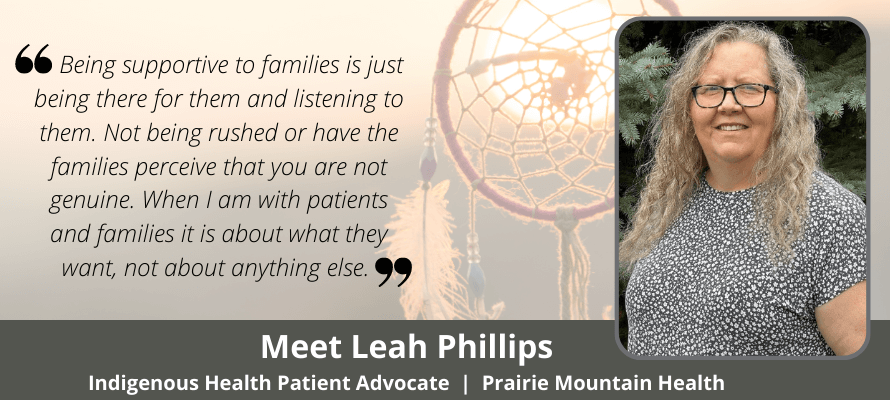Advocate Profile
Indigenous Health Patient Advocate Profile

Tell us about the Indigenous Health Patient Advocate. What key roles come with the positon?
“The key role to the position is to support Indigenous patients that seek or are accessing care at the BRHC or other Health Centres in PMH, which includes 14 First Nation Communities and 2 Metis Federations based in Dauphin and Brandon.”
Is this a position based solely for Brandon or does it serve other areas of PMH?
“This position is for the entire PMH area. Currently there is another Indigenous Health Patient Advocate career posting for Virden, Russell and Hamiota area.”
Can you provide some background about yourself that made you a great fit for this role?
“Born and raised in The Pas, MB, family is Metis, lived in Indigenous Communities, and am passionate about Advocacy and speaking for those who are not able to speak.”
Support to families is a very key part of this initiative. Can you expand on that?
“Being supportive to families is just being there for them and listening to them. Not being rushed or have the families perceive that you are not genuine. When I am with patients and families it is about what they want, not about anything else. I tell families and patients when they ask what I do, I just say that I am there for you, if you need anything just call and I will come see you.”
End of Life care is also very prominent in this advocacy role. What are some of the key guiding principles in this regard?
“End of life is the final stage, when a person is transitioning to go to the spirit world, family is so important. When COVID restrictions were in the red zone families were not able to be with their loved ones at the time. You had to look at other ways such as Facetime, Zoom, and other technology. With one particular situation I will never forget, a family member was transferred here from another hospital from a community from up north. This patient was never going to go home. The family members all came in and after explaining to upper management what the situation was, I was able to liaise with family members to come and see their loved one who by that time went to palliative care. I took care of the family members so that nursing staff would be able to focus on doing their job and not have to worry about family members.”
Is the key to the position, listening and connecting? How are these two important factors achieved?
“Absolutely, one cannot be without the other. I don’t know the patient or their families or their situation. I go in, tell the patient who I am, and ask how can I help you. If they choose to talk, they do, if not I will leave my card and tell them to take care and call me if need be. Another way I approach is just to ask “how are you”. If the patient is able to have liquids and not restricted to have any liquids I ask if I can get them a tea or coffee. Just be authentic.”
Traditions, culture and respect are very much at the forefront of this role. How do these areas get reinforced when raising issues or concerns back to Prairie Mountain Health? What does PMH do with the feedback?
“If a person doesn’t know if they are doing wrong, and no one tells them it keeps going on. I have built a relationship with my managers so that if there is an issue that I have been called in on, or a concern, I take this forward to my managers, then together we can come to a solution that will benefit all. PMH does the best that it can with educating staff on Indigenous Issues, and staff training on such issues. By just simply by talking and keeping the dialogue open is very important as well as to keep building relationships.”
Besides patient or client concerns/questions, what other important tasks does the Patient Advocate undertake?
“Assist in family meetings, discharge planning, travelling to First Nation Communities for Service to Service meetings, assist in accessing services, and help facilitate Spiritual and Cultural care. Bridging the gap between services, and to try to create a better understanding for all cultures.”
Can you note an example(s) of a positive outcome or feedback that supports the very important aspects of what you do?
“One positive thing I can recall is when I assisted a patient that had been in hospital, and was trying to get to Winnipeg to get to an appointment, but didn’t have the resources available. I assisted the patient with how to get in touch with the appropriate agencies with in our city of Brandon to get her into Winnipeg. I still get phone calls from previous patients and their families to let me know how they are doing. It is a good feeling knowing that you have helped someone when they were not able to.
When I meet with patients a few of them have said that they had a family member come into hospital and that I helped them so this is another way that I know what I am doing is a good thing.”
How can persons contact or get in touch with the Indigenous Patient Advocate?
Call me at 204-578-2317, or 431-541-1748 or email [email protected]

